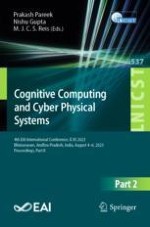2024 | Book
Cognitive Computing and Cyber Physical Systems
4th EAI International Conference, IC4S 2023, Bhimavaram, Andhra Pradesh, India, August 4-6, 2023, Proceedings, Part II
Editors: Prakash Pareek, Nishu Gupta, M. J. C. S. Reis
Publisher: Springer Nature Switzerland
Book Series : Lecture Notes of the Institute for Computer Sciences, Social Informatics and Telecommunications Engineering
